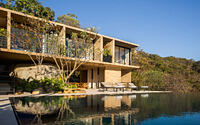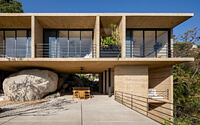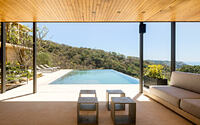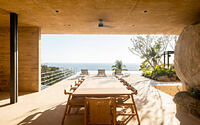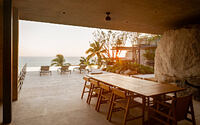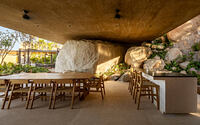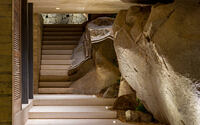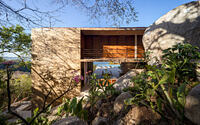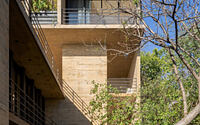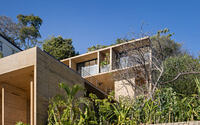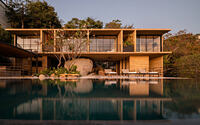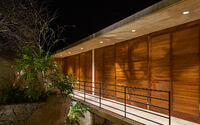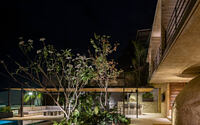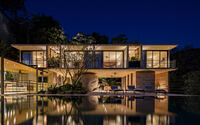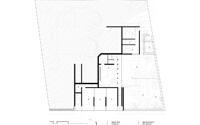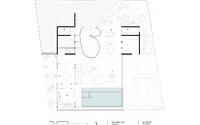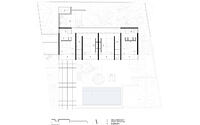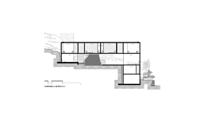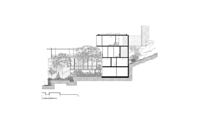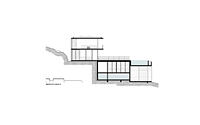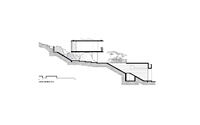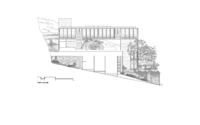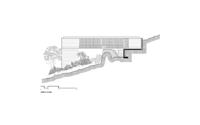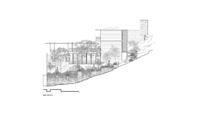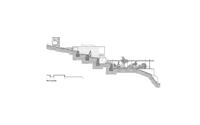Casa Piedra Acapulco by Taller Gabriela Carrillo
Casa Piedra Acapulco is a concrete residence located in Acapulco, Mexico, designed in 2020 by Taller Gabriela Carrillo.














Description
Casa Piedra is located in Brisas Marqués, a residential neighborhood on a peninsula between the traditional Acapulco Bay and Puerto Marqués Bay in the state of Guerrero. The essential characteristic of this complex is that it is located in a deposit of granite rocks of great antiquity that define the type of soil in the bay. On a 1000-square-meter site, located 100 meters above sea level and 300 meters from the sea limit, the almost regular and constrained site presented a couple of major challenges to solve.
First of all, to preserve as far as possible the rocky spirit found, an immense sea of stones, particularly two enormous pieces of more than two meters in diameter in the center of the terrain. The second, dilute the scale of the house in the topography with more than 17 meters of difference in level from the lowest point; looking for the equilibrium point where the sea appeared, the wind flowed and the existing rock at the heart of the project slipped under the portico-house to blur the boundaries between the natural terrain and human interventions.
The big challenge was to scale in sight the size of the house, by solving a simple scheme where the ¨plaza¨ unfolds from the stony ground and a simple portico houses at its highest level the four rooms of the intimate program to almost settle on the central stone, and then slide into the topography.
The complexity of the house is not found in the simple regular scheme, but in the encounters with the nature of the stones, the trees and the existing topography. The target was to create completely open social areas with only a few closed elements such as the main kitchen and the television room but always seeing and honoring the rocks.
Reduce the architecture to a minimum to find in the frames and infinite horizons of the pool, the sea and the jungle the spatial construction of the spaces. A house that has no front or rear, but opens to various landscapes with the same hierarchy; finding in the different levels the opportunity to house the service areas, cisterns, warehouses and a small independent department; creating terraces and rest areas with different opportunities for views and sunning in close dialogue with nature. The staircase is an axis that runs through all levels, from the parking lot to the rooms floor, in a straight line, sometimes contained between walls and others in tension with the rock and the spaces.
The structural system of the portico, covers with just a few centimeters of separation from the central stone a clearing of more than 12 meters long with two solid slabs 20 centimeters thick that reach fine 3×6-inch ptrs that are again opened to observe the stone, without beams or intermediate columns. This action is possible thanks to the vierendeel beam accomplished by the last two slabs and the dividing walls of the rooms, which at the same time allow the south and north facades to be completely freed from any bearing element; looking for the cross wind in all spaces to avoid the use of artificial systems as well as to promote natural light and ventilation of any service.
The use of a single material, concrete with color, product of the mix of cement and local sand achieves the colour of the local beaches. Apparent cast concrete walls and washed and anti-slip floors, with low light reflection but also of low thermal absorption were important to be able to walk without shoes around the whole house. The formwork wood was reused to make lattices and light structures, as well as the stone produced by the same excavations was used to define terraces and containments. Intelligent solar panel systems for the pool and photovoltaic systems for electrical energy as well as water treatment systems make the house practically autonomous from the local infrastructure.
In essence, to build a tension, between the waves of stones and the orthogonal lines of what was built, between technology and primitive standards of inhabiting a space and another between the inner limits and the horizon of the landscapes.
The essential characteristic of this complex is that is located in a deposit of granite rocks of great antiquity that define the type of soil in the bay. On a 1000-square-meter site, located 100 meters above sea level and 300 meters from the sea limit, the almost regular and constrained site presented a couple of major challenges to solve. First of all, to preserve as far as possible the rocky spirit found, an immense sea of stones, particularly two enormous pieces of more than two meters in diameter in the center of the terrain. The second, dilute the scale of the house in the topography with more than 17 meters of difference in level from the lowest point. The target was to create completely open social areas with only a few closed elements such as the main kitchen and the television room but always seeing and honoring the rocks.
The use of a single material, concrete with color, product of the mix of cement and local sand achieves the colour of the local beaches. Apparent cast concrete walls and washed and anti-slip floors, with low light reflection but also of low thermal absorption were important to be able to walk without shoes around the whole house. The formwork wood was reused to make lattices and light structures, as well as the stone produced by the same excavations was used to define terraces and containments. Intelligent solar panel systems for the pool and photovoltaic systems for electrical energy as well as water treatment systems make the house practically autonomous from the local infrastructure.
In essence, to build a tension, between the waves of stones and the orthogonal lines of what was built, technology and primitive standards of inhabiting a space and another the inner limits and the horizon of the landscapes.
Photography courtesy of Taller Gabriela Carrillo
Visit Taller Gabriela Carrillo
- by Matt Watts